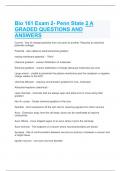Bio 161 exam - Study guides, Class notes & Summaries
Looking for the best study guides, study notes and summaries about Bio 161 exam? On this page you'll find 111 study documents about Bio 161 exam.
Page 3 out of 111 results
Sort by
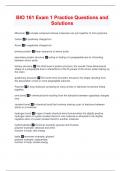
-
BIO 161 Exam 1 Practice Questions and Solutions
- Exam (elaborations) • 9 pages • 2024
-
Available in package deal
-
- $9.99
- + learn more
Monomer A simple compound whose molecules can join together to form polymers Cation A positively charged ion Anion A negatively charged ion primary protein linear sequence of amino acids secondary protein structure coiling or folding of a polypeptide due to H-bonding between amino acids tertiary structure The third level of protein structure; the overall, three-dimensional shape of a polypeptide due to interactions of the R groups of the amino acids making up the chain. quaternary structur...
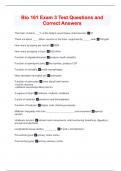
-
Bio 161 Exam 3 Test Questions and Correct Answers
- Exam (elaborations) • 10 pages • 2024
-
Available in package deal
-
- $10.49
- + learn more
The brain contains ___% of the body's neural tissue (interneurons) 97 There are about ____ billion neurons in the brain, supported by _____ cells 100;glial How many synapses per neuron 5000 How many synapses in brain 500 trillion Function of oligodendrocytes produce myelin sheaths Function of ependymal cells line cavities, produce CSF Function of microglia small macrophages Most abundant neuroglial cell astrocytes Function of astrocytes -form blood brain barrier -nourish neurons -reabso...

-
BIO 161 Exam 1 Practice Questions and Correct Answers
- Exam (elaborations) • 7 pages • 2024
-
Available in package deal
-
- $8.99
- + learn more
4 levels of life cell, tissue, organ, organ system 7 characteristics of life 1. organized (composed of cells) 2. acquire materials and energy (capacity to do work and metabolize) 3. homeostatic 4. reproduce 5. potential for growth 6. have evolutionary history/heredity of traits (adapt and evolve) 7. respond to stimuli (internal or external and leads to response) Why do humans belong to the domain Eukarya and kingdom Animalia? Eukarya: because we have nuclei, organelles, a cell membrane, and an...
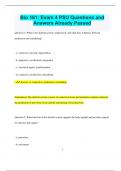
-
Bio 161: Exam 4 PSU Questions and Answers Already Passed
- Exam (elaborations) • 31 pages • 2024
-
Available in package deal
-
- $10.49
- + learn more
Bio 161: Exam 4 PSU Questions and Answers Already Passed Question 1: What is the skeletal system composed of, and what does it balance between production and remodeling? - a. connective; growth; regeneration - b. supportive; ossification; integration - c. structural; repair; transformation - d. connective; production; remodeling - Answer: d. connective; production; remodeling Explanation: The skeletal system consists of connective tissue and maintains a balance between the pro...
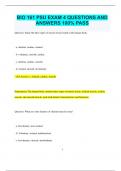
-
BIO 161 PSU EXAM 4 QUESTIONS AND ANSWERS 100% PASS
- Exam (elaborations) • 11 pages • 2024
-
Available in package deal
-
- $9.99
- + learn more
BIO 161 PSU EXAM 4 QUESTIONS AND ANSWERS 100% PASS Question: Name the three types of muscle tissue found in the human body. - a. skeletal, cardiac, striated - b. voluntary, smooth, cardiac - c. skeletal, cardiac, smooth - d. striated, smooth, involuntary - Answer: c. skeletal, cardiac, smooth Explanation: The human body contains three types of muscle tissue: skeletal muscle, cardiac muscle, and smooth muscle, each with distinct characteristics and functions. Question: What a...
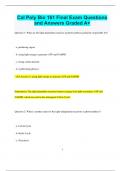
-
Cal Poly Bio 161 Final Exam Questions and Answers Graded A+
- Exam (elaborations) • 32 pages • 2024
-
- $10.49
- + learn more
Cal Poly Bio 161 Final Exam Questions and Answers Graded A+ Question 1: What are the light-dependent reactions in photosynthesis primarily responsible for? - a. producing sugars - b. using light energy to generate ATP and NADPH - c. fixing carbon dioxide - d. synthesizing glucose - Answer: b. using light energy to generate ATP and NADPH Explanation: The light-dependent reactions harness energy from light to produce ATP and NADPH, which are used in the subsequent Calvin Cycle. ...
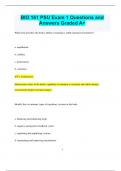
-
BIO 161 PSU Exam 1 Questions and Answers Graded A+
- Exam (elaborations) • 21 pages • 2024
-
Available in package deal
-
- $9.99
- + learn more
BIO 161 PSU Exam 1 Questions and Answers Graded A+ What term describes the body's ability to maintain a stable internal environment? a. equilibrium b. stability c. homeostasis d. constancy c. homeostasis Homeostasis refers to the body's capability to maintain a consistent and stable internal environment despite external changes. Identify the two primary types of regulatory systems in the body. a. balancing and enhancing loops b. negative and positive feedback cycles c...
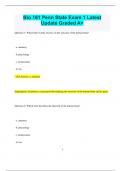
-
Bio 161 Penn State Exam 1 Latest Update Graded A+
- Exam (elaborations) • 18 pages • 2024
-
Available in package deal
-
- $9.99
- + learn more
Bio 161 Penn State Exam 1 Latest Update Graded A+ Question 1: What field of study focuses on the structure of the human body? - a. anatomy - b. physiology - c. homeostasis - d. ion - Answer: a. anatomy Explanation: Anatomy is concerned with studying the structure of the human body and its parts. Question 2: Which term describes the function of the human body? - a. anatomy - b. physiology - c. homeostasis - d. ion 2 - Answer: b. physiology Explanation: Physio...
Bio 161 Exam 2- Penn State 2 A GRADED QUESTIONS AND ANSWERS
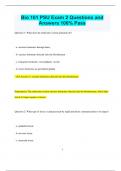
-
Bio 161 PSU Exam 2 Questions and Answers 100% Pass
- Exam (elaborations) • 14 pages • 2024
-
Available in package deal
-
- $9.99
- + learn more
Bio 161 PSU Exam 2 Questions and Answers 100% Pass Question 1: What does the endocrine system primarily do? - a. secretes hormones through ducts - b. secretes hormones directly into the bloodstream - c. transports hormones via lymphatic vessels - d. stores hormones in specialized glands - Answer: b. secretes hormones directly into the bloodstream Explanation: The endocrine system releases hormones directly into the bloodstream, which then travel to target organs or tissues. ...

Did you know that on average a seller on Stuvia earns $82 per month selling study resources? Hmm, hint, hint. Discover all about earning on Stuvia



